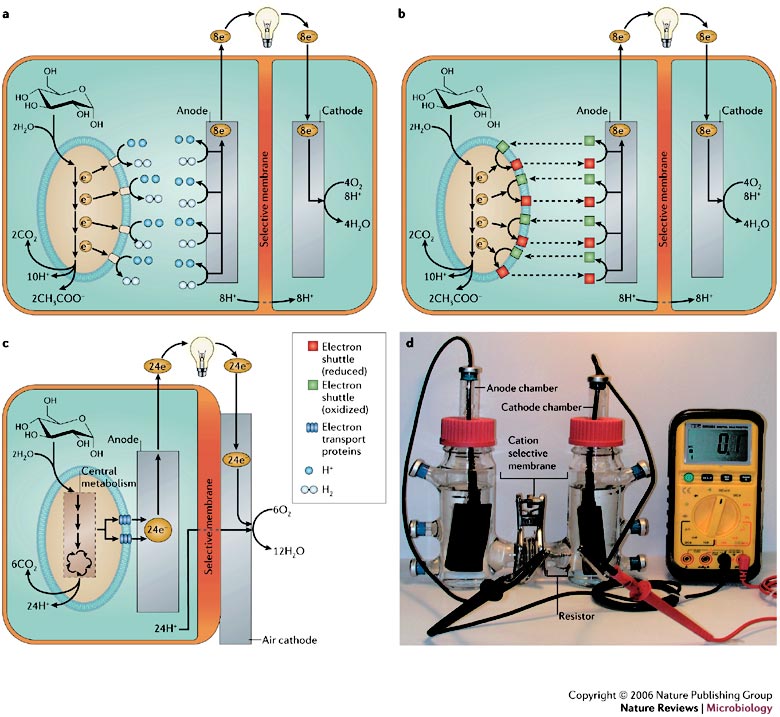[Glucose serves as an example fuel. a | An
indirect microbial fuel cell. A fermentative microorganism converts
glucose to an end product, hydrogen, which can abiotically react with
the anode to produce electrons and protons. This process only partially
recovers the electrons available in the organic fuel as electricity,
and results in the accumulation of organic products in the anode
chamber. b | A mediator-driven microbial fuel
cell. An electron-shuttling mediator accepts electrons from reduced
cell constituents and abiotically transfers the electrons to the anode.
The reoxidized mediator can then undergo repeated cycles of reduction
and oxidation. In most instances, the cells that have been used in such
fuel cells only incompletely oxidize their organic fuels as shown. c
| The oxidation of glucose to carbon dioxide with direct electron
transfer to the electrode surface. Glucose is taken into the cell and
oxidized to carbon dioxide by typical central metabolic pathways, such
as the tricarboxylic acid (TCA) cycle. Electrons derived from glucose
oxidation are transferred across the inner membrane, periplasm, and
outer membrane through electron transport proteins, such as c-type
cytochromes. In this example, the system is illustrated with an air
cathode rather than a cathode submerged in water. d
| A two-chambered microbial fuel cell. This system is not optimized for
maximum power production but is convenient for microbiological studies.]
Four basic reactor configurations using bacteria can be
distinguished in biofuel cells:
•
The uncoupled bioreactor MFC:
microbiological hydrogen production or methane production (with subsequent reforming) in a separate bioreactor followed by a chemical fuel cell (generally high
temperature SOFC) to convert hydrogen gas into electricity •
The integrated bioreactor MFC:
microbiological hydrogen production and hydrogen to electricity conversion in a single cell.
•
The MFC with direct electron transfer: microbiological electricity generation and direct electron transfer to the anode.
•
The MFC with mediated electron transfer: microbiological electricity generation and electron transport towards the anode by means of electron shuttling mediators.
Since micro-organisms act as a catalyst in the transfer of
electrons from the substrate to the anode, the selection of a high performing
microbial consortium (either pure or mixed culture) is of crucial importance in
the ‘real’ microbial fuel cells. The electron transfer from the bacterium to
the anode can proceed in a direct way from the bacterial membrane to the anode
surface or indirectly by means of a mediator. Alternatively, biofuel cells
exist, that use enzymes, which are immobilized on the anode surface. These fuel
cells can not be regarded as MFCs sensu strictu. Due to the high costs involved
in enzyme production, enzymatic fuel cells are only suitable for miniaturized
small-scale applications. As a result, dimensions and corresponding power
outputs are significantly smaller. Commonly used enzymes are glucose-oxidase
and dehydrogenases.


